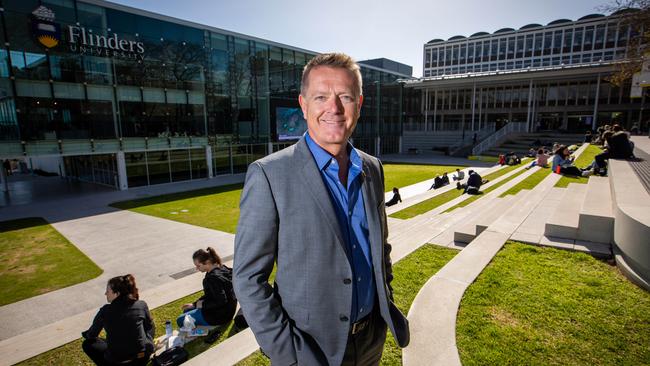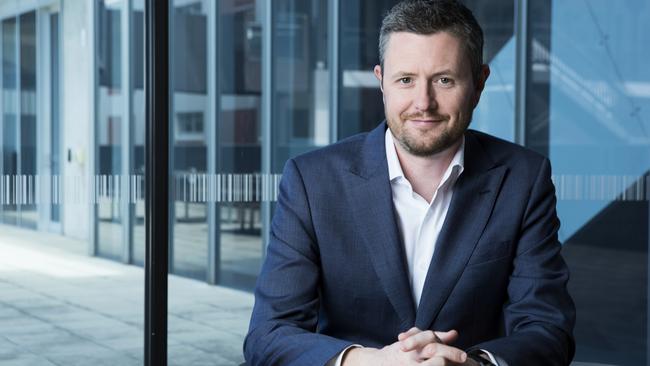South Australian universities attempt to hold as many jobs as possible despite shortfall of hundreds of millions
The pandemic lockdown devastated the income of all South Australia’s universities, and they fear next year will be even harder. But work is afoot to keep students and teachers aboard.
South Australia’s universities face a financial hole of hundreds of millions of dollars which is expected to get deeper next year but they are urgently pulling as many levers as possible to save jobs.
Extra money will come from signing up more local students, selling short courses, attracting research and promoting SA as a safe destination for international students.
Supporting 8,500 direct jobs, generating the state’s largest share of export revenue as well as educating the future workforce, the financial health of universities is critically important to SA.
Last year, the three major universities operated profitably, coming out $88 million in the black on $2.2 billion of revenue, according to reports tabled last week in Parliament.
This included Adelaide University turning around a $4 million loss in 2018 to a $41 million positive result.
However, all three project massive downturns this year because of the coronavirus pandemic and fear an accelerating deterioration next year.
Flinders University faces a shortfall of up to $54 million this year but Vice-Chancellor Colin Stirling said it was important to dissect that.

“There are aspects of our financial projections we need to deal with and then there are aspects which annually fluctuate up and down,” he said.
“The real impost this year is the reduction in our teaching revenue.
“That’s $20 million this year and I’ve told staff it could be $46 million next year.
“Those are the numbers that really matter.
“Investments go up and down – I’m not going to be cutting jobs because we’ve lost money on the stock market.”
“We’ve absorbed the $20 million of savings we required this year.
“For 2021, we might face this $46 million hole.
“That’s our worst-case projection.
“What we’re seeking to do is to ensure that does not become our reality and that we can grow our revenues to cover some or all of that position.”
UniSA Vice-Chancellor David Lloyd said his forecasts looked at a worst-case scenario of a shortfall of $30 million this year, and $90 million next year.

“And a lot of things have to go wrong for that,” he said.
“For 2021, the worst case is worse than this year.
“If international borders open, that takes the edge off.
“If we have rehabilitation of the relationship between the Australian and Chinese Governments, it takes pressure off.
“If we have the means to enrol students offshore and have them get a certificate of enrolment knowing they’re going to be able to transition back onshore, that’ll take the edge off.
“There are a number of things that, if they happen, they’ll mitigate that worst case and it’ll come back to a more manageable number.
“But if none of those things happen, if there’s a massive second wave or there’s the impact of a global recession – all the things we can’t control – then I have a worst-case number.”
Adelaide University faces the biggest financial challenge because it is the most reliant on international students.
Adelaide had expected revenue to exceed $1 billion this year but it now projects a $100 million shortfall on that target, followed by a further $150 million dip in 2021.
“We know that our university is not alone in facing significant headwinds,” Acting Vice-Chancellor Mike Brooks said.

“Most Australian universities face major financial challenges in the years ahead.
“We are committed to exploring every avenue for preserving jobs.”
Adelaide has already deferred new capital works, paused hiring new staff other than exceptionally talented individuals and taken on short-term borrowings.
It is considering further tightening for 2021, including temporary pay cuts as part of a jobs’ preservation pact with staff.
To attract more students, Adelaide has created 12 new undergraduate and 21 postgraduate programs for a September intake.
These programs, offered for 2020 commencements only, focus on international students who are offshore and unable to reach campus.
Adelaide also is offering discounted places in two short-course programs – in cyber security and nursing – to upskill the workforce and generate fees for the university.
Professor Stirling said revenue growth at Flinders would come from increased enrolment of domestic and international students.
“We are already seeing an uplift in applications from domestic students for places in Semester 2 this year,” he said.
This was linked to the economic downturn with workers wanting to learn skills and seize future job opportunities.
It is expected fewer school leavers will take a gap year, leading to increased applications to uni next year.
Fee changes announced on Friday by federal Education Minister Dan Tehan also would influence enrolments but it was too early to fully assess that, Professor Stirling said.
Mr Tehan aims to make some courses cheaper – such as nursing and engineering – but others such as law and economics more expensive as well as make students pay a bigger share of costs overall.
Flinders’ worst-case scenario was based on a “grim outlook” for international enrolments in 2021, Professor Stirling said.
If a proposed pilot scheme to fly back students reopened the pathway and allowed significant numbers to reach Adelaide “that would considerably mitigate” the looming financial hole.
“If you were a parent of a child you were going to send overseas to study, then you would want to pick a jurisdiction that took care of the students,” Professor Stirling said.
“One that is a safe destination and that handled the pandemic well.
“The SA Government and SA universities were the first in the country to offer some financial assistance to international students in distress.”
Professor Lloyd said UniSA had a diverse spread of international students, drawn from more than 80 countries.
There were many continuing students at undergraduate through to PhD level but the pressure would build if borders remained closed and there were no new students coming in.
Fanging it – SA research aids global fight
Snake fangs are extraordinarily efficient at piercing the target – a characteristic researchers from Flinders and Adelaide universities aim to apply to human medicine.
“We want to know whether we can take the design into biomedical technologies,” said Alessandro Palci, who is leading a project on snake evolution which won a $441,000 grant in the latest round from the Australian Research Council.
“We will create a big database on venomous snakes in Australia and other countries, which will be a stepping stone to applications.”

Snakes had fangs that could pierce a fluffy bird or a big tough-skinned reptile and some, such as tiger snakes, changed as the animal grew into adulthood.
These were concepts which could inform development of needles, syringes and other devices.
The project, which involves Flinders Professor Michael Lee and Adelaide University’s Emma Sherratt, will use resources of the SA Museum.
“Snakes are a major medical issue around the world,” said Dr Sherratt, a specialist in mathematical modelling of shapes. “A lot of people are injured or even die from snake bites every year.
“Understanding the apparatus which delivers the venom will help snakebite research.”
The project would investigate distribution changes and diet within Australia of species over time, “so we can then make inferences about climate change”, said Dr Palci, who studied in Italy and Canada before moving to Adelaide.
There has been controversy “going on for centuries, maybe” about why snakes lost their legs when they evolved from lizards, he said. He hopes the project will contribute to that debate.
Best minds finding answers in a crisis
Researchers in South Australia are defying the pandemic economic downturn, winning new grants and mobilising rapidly to take on the challenges posed by COVID-19.
Research is lifeblood for universities, creating reputation which drives rankings and then revenue.
Flinders University committed in 2019 to allocating an extra $100 million to research over five years and vice-chancellor Colin Stirling is optimistic that will be honoured despite the financial squeeze.
“I’m hopeful we’ll be able to maintain those investments because it’s important for us to increase our research activity and impact,” he said.
“One of the things we’ve seen during this pandemic is the importance of having a pool of great researchers.
“We’ve been able to turn on a sixpence and our researchers have focused on really important issues around the consequences of the pandemic.
“We have a trial under way on a COVID-19 vaccine, we have researchers who have enabled the manufacture of personal protective equipment in this state.
“Our researchers have been able to get straight in and deliver – that’s a huge resource for the community.”
Researchers and clinicians from Flinders and the South Australian Health and Medical Research Institute last week were awarded $1.4 million to improve early detection and treatment for indigenous Australians at risk of blindness through diabetes.
Professor Jamie Craig said the three-year project, supported by the Medical Research Future Fund, would involve cultural leaders, medical researchers and artificial intelligence teams.
At UniSA, research has not slowed.
“We have had a lot of people who really stepped up and engaged in pandemic-facing research, we have people working on vaccines, there’s a lot on mental health and resilience,” vice-chancellor David Lloyd said.
“Then there’s the pandemic drone which can scan crowds.”
The drones can monitor temperature, heart and respiratory rates and detect people sneezing and coughing, in a project led by Professor Javaan Chahl with Canadian-based company Draganfly.
UniSA molecular biologist Gokhan Cildir is working with US company Atomwise to use artificial intelligence to seek compounds to block the “spike” protein which COVID-19 uses to invade human cells.
Health and biotech are priorities at Adelaide University.
“We have already seen an accelerated and co-operative approach to research globally into various aspects of COVID-19, with University of Adelaide researchers involved in that work,” acting vice-chancellor Mike Brooks said.
“We can expect to see a broader range of research projects investigating pandemics and infectious diseases, and their wider implications, such as economic impacts and recovery.”
